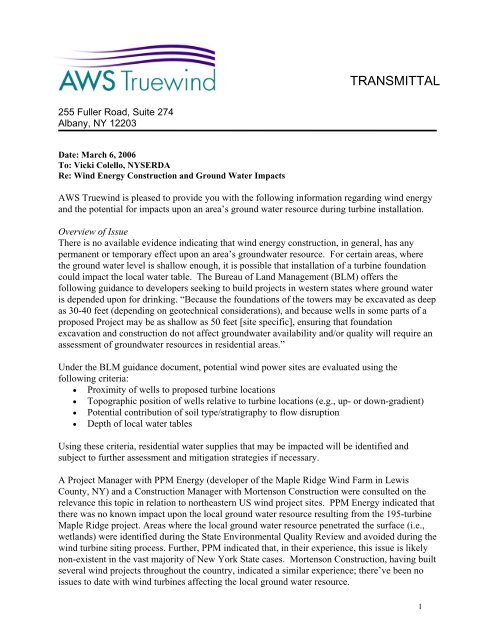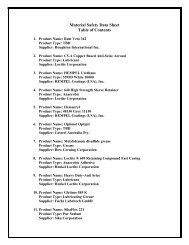Wind Energy Construction and Ground Water Impacts. - Noble ...
Wind Energy Construction and Ground Water Impacts. - Noble ...
Wind Energy Construction and Ground Water Impacts. - Noble ...
You also want an ePaper? Increase the reach of your titles
YUMPU automatically turns print PDFs into web optimized ePapers that Google loves.
TRANSMITTAL255 Fuller Road, Suite 274Albany, NY 12203Date: March 6, 2006To: Vicki Colello, NYSERDARe: <strong>Wind</strong> <strong>Energy</strong> <strong>Construction</strong> <strong>and</strong> <strong>Ground</strong> <strong>Water</strong> <strong>Impacts</strong>AWS Truewind is pleased to provide you with the following information regarding wind energy<strong>and</strong> the potential for impacts upon an area’s ground water resource during turbine installation.Overview of IssueThere is no available evidence indicating that wind energy construction, in general, has anypermanent or temporary effect upon an area’s groundwater resource. For certain areas, wherethe ground water level is shallow enough, it is possible that installation of a turbine foundationcould impact the local water table. The Bureau of L<strong>and</strong> Management (BLM) offers thefollowing guidance to developers seeking to build projects in western states where ground wateris depended upon for drinking. “Because the foundations of the towers may be excavated as deepas 30-40 feet (depending on geotechnical considerations), <strong>and</strong> because wells in some parts of aproposed Project may be as shallow as 50 feet [site specific], ensuring that foundationexcavation <strong>and</strong> construction do not affect groundwater availability <strong>and</strong>/or quality will require anassessment of groundwater resources in residential areas.”Under the BLM guidance document, potential wind power sites are evaluated using thefollowing criteria:• Proximity of wells to proposed turbine locations• Topographic position of wells relative to turbine locations (e.g., up- or down-gradient)• Potential contribution of soil type/stratigraphy to flow disruption• Depth of local water tablesUsing these criteria, residential water supplies that may be impacted will be identified <strong>and</strong>subject to further assessment <strong>and</strong> mitigation strategies if necessary.A Project Manager with PPM <strong>Energy</strong> (developer of the Maple Ridge <strong>Wind</strong> Farm in LewisCounty, NY) <strong>and</strong> a <strong>Construction</strong> Manager with Mortenson <strong>Construction</strong> were consulted on therelevance this topic in relation to northeastern US wind project sites. PPM <strong>Energy</strong> indicated thatthere was no known impact upon the local ground water resource resulting from the 195-turbineMaple Ridge project. Areas where the local ground water resource penetrated the surface (i.e.,wetl<strong>and</strong>s) were identified during the State Environmental Quality Review <strong>and</strong> avoided during thewind turbine siting process. Further, PPM indicated that, in their experience, this issue is likelynon-existent in the vast majority of New York State cases. Mortenson <strong>Construction</strong>, having builtseveral wind projects throughout the country, indicated a similar experience; there’ve been noissues to date with wind turbines affecting the local ground water resource.1
In closing, it is worth noting that unlike other power generation facilities, wind turbines useabsolutely no freshwater during the course of their day-to-day operations. In contrast, electricitygenerated by nuclear <strong>and</strong> coal facilities m<strong>and</strong>ates the use of copious amounts of freshwater on acontinuous basis. Lastly, there is no evidence indicating that wind turbines in general have anyadverse effect upon an area’s freshwater resource.Web SitesThe National <strong>Wind</strong> Coordinating Committee’s Permitting H<strong>and</strong>bookhttp://www.nationalwind.org/publications/permit/nwccch4.pdfBureau of L<strong>and</strong> Management Guidance Documenthttp://windeis.anl.gov/documents/fpeis/maintext/Vol1/Vol1Ch5.pdf2





